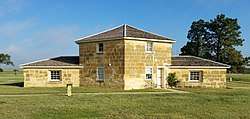Fort Hays Limestone Member
The Fort Hays Limestone is a member of the Niobrara Formation of the Colorado Group exposed in Colorado, Kansas, Nebraska, and South Dakota and is named for the bluffs near the old Fort Hays, a well-known landmark in western Kansas.[1][2]
| Fort Hays Limestone Stratigraphic range: Cretaceous | |
|---|---|
 Fort Hays Limestone in the K-147 road cut at the Cedar Bluff State Park, Kansas, USA. | |
| Type | Formation Member |
| Unit of | Niobrara Formation of the Colorado Group |
| Underlies | Smoky Hill Chalk Member of the Niobrara Formation |
| Overlies | Non-conformably, Codell Sandstone, Blue Hill Shale, or Juana Lopez members of the Carlile Formation |
| Lithology | |
| Primary | Limestone |
| Other | Shale partings |
| Location | |
| Region | Mid-continental: Colorado, Kansas, Nebraska, South Dakota |
| Country | |
| Type section | |
| Named for | Fort Hays |
| Named by | S. W. Williston[1] |
| Location | Hogback ridge just west of old Fort Hays, Kansas |
| Year defined | 1893[1] |
Defining the southeast border of the High Plains, the towering stone-capped bluffs of the Fort Hays Escarpment are "perhaps the most conspicuous physiographic boundary in Kansas."[3]

The Fort Hays Limestone was a generally practical building stone. However, it deteriorates in when in contact with soil (note the repaired foundation on the Old Fort Hays Blockhouse). In contrast, the Fencepost limestone is quite durable in the ground, so, the Fencepost can be seen in foundation course of buildings that are otherwise faced with Fort Hays Limestone. Particularly in Hays and Ellis, where the Fort Hays and Fencepost outcrops are in close geographic proximity, the two limestones are seen in combination in buildings.[4][5]
See also
References
- Daniel F. Merriam (1963). "The Geologic History of Kansas". Kansas Geological Survey Bulletin. Kansas Geological Survey (162). Retrieved 2017-01-22.
The term Fort Hays is derived from old Fort Hays, a well-known landmark in western Kansas, and was first used by Samuel Wendell Williston in 1893.
- Howard E. Simpson. "Geology of the Yankton Area South Dakota and Nebraska" (PDF). Geological Survey Professional Paper. U.S. Department of the Interior (328).
- Grace Muilenburg and Ada Swineford (1975). "Wence the Fence: Geology of the Post Rock". Land of the Post Rock – Its Origins, History, and People. University Press of Kansas, Lawrence. pp. 89–91.CS1 maint: uses authors parameter (link)
- Warren G. Hodson (1965). Geology and Ground-Water Resources of Trego County, Kansas, Kansas Geological Survey, Bulletin 174. University of Kansas Publications, State Geological Survey of Kansas. p. Economic Geology, continued.
The Fort Hays Limestone Member of the Niobrara Chalk has been quarried for structural stone at numerous localities in Trego County. The Fort Hays is relatively soft, although it hardens upon weathering. The Fort Hays also tends to absorb water and thus to deteriorate through freeze-and-thaw action and from spalling. Many farm buildings, city dwellings, and business houses in the area constructed of the Fort Hays Limestone seem to stand up well for many years, however. In a report by Risser (1960) the sources and characteristics of building stone in Kansas are discussed.
- Alvin R. Leonard and Delmar W. Berry (1961). Geology and Ground-water Resources of Southern Ellis County and Parts of Trego and Rush Counties, Kansas, Kansas Geological Survey, Bulletin 149. University of Kansas Publications, State Geological Survey of Kansas. p. Geography.
In addition to fence posts, the [Fencepost] limestone has been used widely in southern Ellis County and elsewhere for foundations and buildings. Among the buildings constructed from this stone are the magnificent Catholic churches at Pfeifer, Victoria, and Liebenthal and the principal buildings at the Fort Hays State College in Hays. Newer buildings constructed from sawed blocks of this stone include the Methodist church and the Ellis County courthouse in Hays. ... The Fort Hays Limestone member of the Niobrara Chalk also has been quarried for structural stone, although it is not as weather-resistant as the "Fencepost" Limestone bed. It is softer than the Greenhorn Limestone and spalls badly when used for foundation stone.